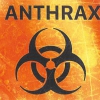Anthrax
What is anthrax?
 Anthrax is a rare infectious disease caused by the bacterium Bacillus anthracis. It can occur in wild and domestic hoofed animals, such as cattle, sheep, goats, etc. It can also occur in humans when they are exposed to the bacterium. There are 3 forms: cutaneous (skin), inhalation (lungs), and gastrointestinal (stomach and intestines). With intentional exposure, as in a bioterrorist release, breathing in the spores or contact with openings in the skin (cuts, scratches, abrasions, etc.) are the most likely routes of entry into the body. Gastrointestinal anthrax occurs when people eat meat from anthrax-infected animals.
Anthrax is a rare infectious disease caused by the bacterium Bacillus anthracis. It can occur in wild and domestic hoofed animals, such as cattle, sheep, goats, etc. It can also occur in humans when they are exposed to the bacterium. There are 3 forms: cutaneous (skin), inhalation (lungs), and gastrointestinal (stomach and intestines). With intentional exposure, as in a bioterrorist release, breathing in the spores or contact with openings in the skin (cuts, scratches, abrasions, etc.) are the most likely routes of entry into the body. Gastrointestinal anthrax occurs when people eat meat from anthrax-infected animals.
What are the symptoms of anthrax?
- Cutaneous (skin): exposed skin itches; large boil-like sore appears; sore becomes a black scab. If not treated, the infection can spread to the lymph nodes and bloodstream.
- Inhalation (lungs): cold or flu-like symptoms; symptoms become severe with serious breathing problems.
- Gastrointestinal (stomach and intestines): fever; abdominal pain; loose, watery bowel movements; vomiting with blood in vomitus.
How soon after exposure would symptoms begin?
Symptoms generally develop between 1 and 7 days after exposure, but prolonged periods up to 60 days after exposure are possible.
Can anthrax be spread person to person?
- Inhalation (lung) anthrax: not spread from person to person.
- Cutaneous (skin) anthrax: drainage from an open sore presents a low risk of infection to others, and this must be direct contact.
- Gastrointestinal (stomach and intestine) anthrax: not spread person to person.
Can anthrax be treated?
If given early in the illness, certain antibiotics are effective against anthrax.
How likely is it that I will be exposed to anthrax, other biological agents?
In West Virginia, the last reported case of human anthrax occurred in 1947. Historically, in the United States, the individual risk of disease from bioterrorism has been very, very small.
What will be done to evaluate an incident?
State and local public health, emergency, and law enforcement agencies will work together to evaluate all incidents. Examining the circumstances of the incident, the suspect material, and the type of exposure is required to determine if the incident represents a public health risk.
Anthrax Information for Public Health Officials
Spore-forming bacteria
Unique Epidemiological Characteristics
- No natural reservoir in West Virginia
- A newly reported case should be urgently investigated considering:
- travel
- highly unusual exposure
- BT
- Incubation: 1-60 days; with most cases occurring within the first week
- No person-to-person transmission
- Mortality: 60-100% for inhalation anthrax and 20% for cutaneous anthrax without therapy — dire emergency
- Environmental: hardy for decades in the spore form
- Treatment (Ciprofloxacin, doxycycline) effective in reducing mortality if begun early
- Prophylaxis (Ciprofloxacin, doxycycline) effective in preventing disease
Laboratory confirmation
Screening tests should be completed by hospital laboratory; confirmation by OLS
Employee Health Considerations
- Personal protective equipment / training required for persons doing environmental investigations
- Prophylaxis required for employees who have been exposed.
- Standard precautions for work with infected individuals
Life-saving Interventions – In Order
- Recognition / reporting / casefinding + early and appropriate therapy
- Risk factor and environmental investigation to establish source of exposure / population at risk AND rapid initiation of prophylaxis
- Antibiotic sensitivity testing of the isolate
Training Considerations
- Physicians: recognition / treatment / reporting
- ICPs: reporting, active surveillance procedures
- Labs: screening tests and procedure for referral to OLS
- Local health departments, regional epidemiologists: NPS issues > investigation
- IDEP / DSDC / BPH: employee health / investigation / priorities for control.
- Environmental Health: personal protective equipment, environmental sampling
